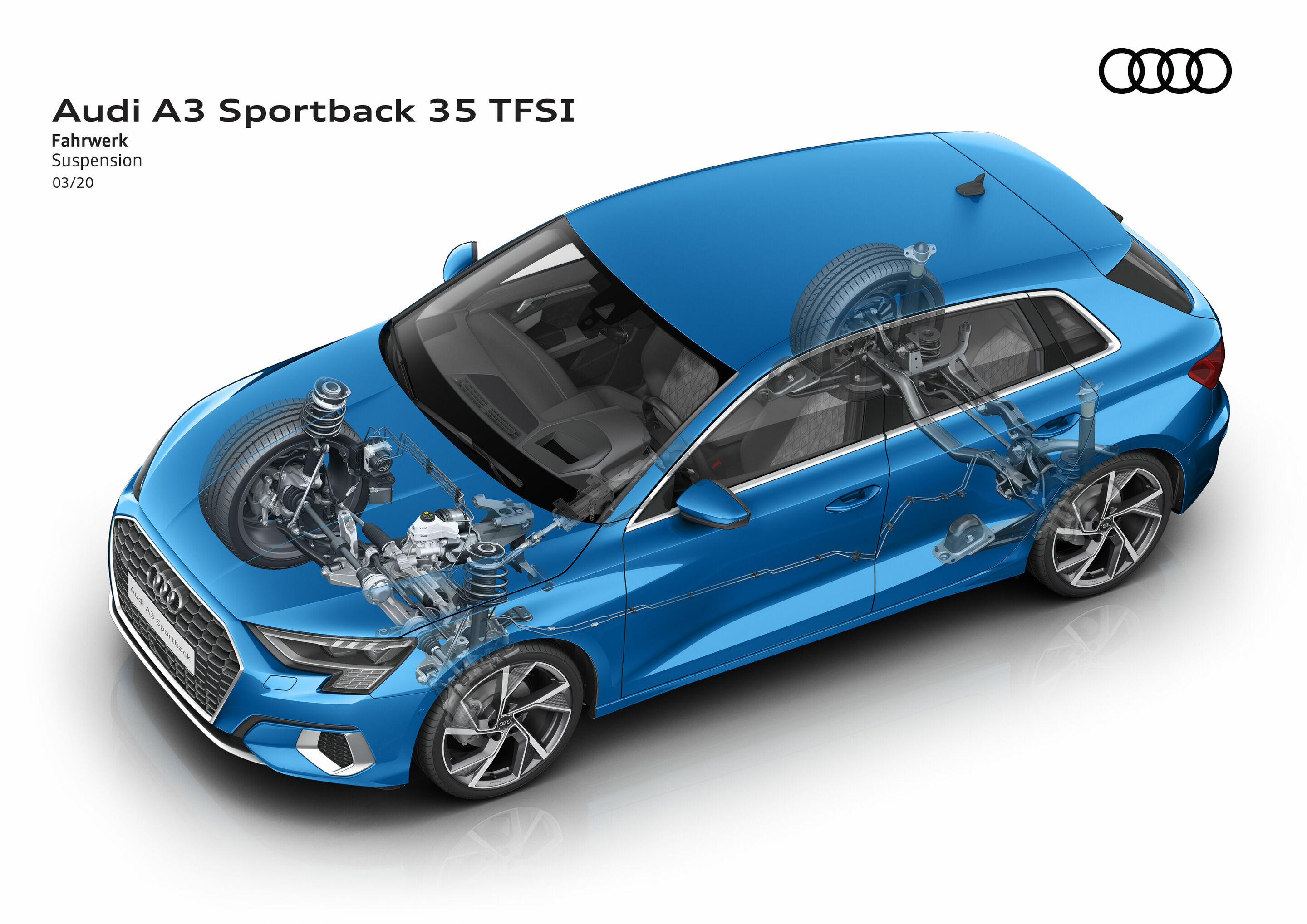Suspension
Back to overviewAgile in town, sporty on country roads, comfortable on the highway – Audi further developed the strengths of the predecessor model in the suspension of the new A3. Even the standard suspension is sporty and balanced, combining pleasant ride comfort with good dynamics. The front and rear track widths have each increased by 11 millimeters (0.4 in), to 1,554 (61.2 in) and 1,525 millimeters (60.0 in) respectively.
With regard to the axle concept, Audi relies on a MacPherson axle with bottom wishbones at the front. Models with an output from 110 kW (150 hp) are equipped with a four-link rear suspension with separate spring/damper arrangement. In the other engine variants, a light and compact torsion-beam rear axle is used. The swivel bearings are made of aluminum.
Even the standard electromechanical steering with speed-dependent power assistance has a sporty and direct gear ratio. The following applies to the optional progressive steering: The further the driver turns in the wheel, the more direct the ratio becomes. This reduces steering effort in urban traffic and when maneuvering; in tight curves, the new A3 is even more agile and precise.
Lowered: two optional suspensions
For the engine variants with an output from 110 kW (150 hp), the suspension is available with adaptive damper control upon request, which lowers the body by 10 millimeters (0.4 in). Sensors measure the vertical acceleration of the body and the relative movement of the individual wheels. The control unit processes their signals within milliseconds. Through valves that regulate the flow of oil, it adapts each damper individually to the road condition, the driving situation, and the setting in the Audi drive select dynamic handling system. Here, the driver can select between dynamic or comfort-oriented basic tuning in the profiles auto, comfort, and dynamic. The suspension with adaptive damper control enables a very wide spread between comfortable roll motion and agile handling. With the sport suspension, which comes as standard with the S line exterior, the focus is clearly on dynamics. Due to the tauter tuning of the suspension and dampers and the fact that the body height is lowered by 15 millimeters (0.6 in), the A3 conveys an even more direct contact with the road surface.
Controlled: Audi drive select and ESC
The driving experience becomes even more varied with the optional Audi drive select system. The driver can use this system to vary not only the dampers, but also the characteristics of the steering assist system and throttle response, as well as the shift points of the S tronic - for the engine variants with 110 kW / 150 hp. In this case, he can select from the profiles auto, comfort, dynamic, efficiency, and individual.
As part of the sensitive and safe regulation of the Electronic Stabilization Control (ESC), the wheel-selective torque control also contributes to dynamic handling: Should the front wheel on the inside of the curve lose grip when cornering at high speed, it is braked slightly to ensure that the car maintains a stable and sporty course.
Centralized: the modular dynamic handling control
New in the A3 is the modular dynamic handling control. The central system collects the data from all components relevant for transverse dynamics and thus ensures that the interplay between them is precise and quick. It computes the optimal settings for the adaptive dampers, the ESC and the quattro drive – predictively based on steering movements. The modular dynamic handling control increases agility in this way, especially on winding roads.
Enlarged: wheels and brakes
The wheel portfolio of the new A3 models ranges from 16 to 19 inches and up to a tire dimension of 235/35. The two exterior lines include 17-inch wheels, while offerings from Audi Sport are available for 18-inch and 19-inch wheels. The tires for all dimensions were optimized in terms of rolling resistance without compromising handling or braking performance.
The brake disks on the front axle are internally ventilated and measure 312 millimeters (12.3 in), while those on the rear axle have a diameter of 272 millimeters (10.7 in). The brake pistons are actuated by an electric brake booster. Due to its very quick response time, the developers were able to increase the air gap between the brake pad and the brake disk slightly. This solution eliminates friction loss due to slight contact with the brake pads and increases efficiency.
All terms in blue in the text are explained in detail in the technology lexicon at www.audi-mediacenter.com/en/technology-lexicon.
The equipment, data and prices stated here refer to the model range offered for sale in Germany. Subject to change without notice; errors and omissions excepted.
